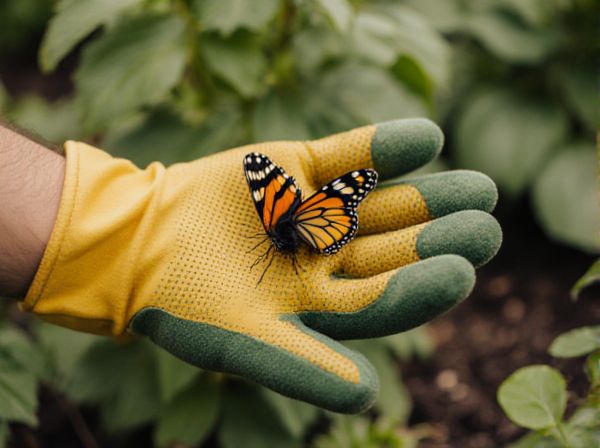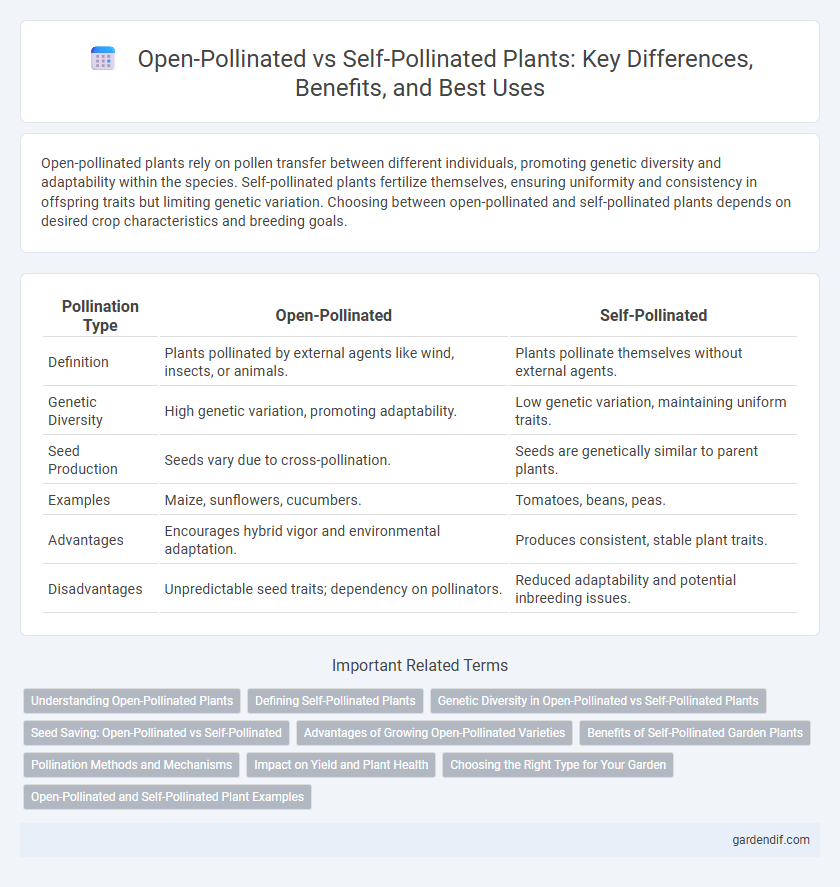
Open-pollinated vs Self-pollinated Illustration
Open-pollinated plants rely on pollen transfer between different individuals, promoting genetic diversity and adaptability within the species. Self-pollinated plants fertilize themselves, ensuring uniformity and consistency in offspring traits but limiting genetic variation. Choosing between open-pollinated and self-pollinated plants depends on desired crop characteristics and breeding goals.
Table of Comparison
| Pollination Type | Open-Pollinated | Self-Pollinated |
|---|---|---|
| Definition | Plants pollinated by external agents like wind, insects, or animals. | Plants pollinate themselves without external agents. |
| Genetic Diversity | High genetic variation, promoting adaptability. | Low genetic variation, maintaining uniform traits. |
| Seed Production | Seeds vary due to cross-pollination. | Seeds are genetically similar to parent plants. |
| Examples | Maize, sunflowers, cucumbers. | Tomatoes, beans, peas. |
| Advantages | Encourages hybrid vigor and environmental adaptation. | Produces consistent, stable plant traits. |
| Disadvantages | Unpredictable seed traits; dependency on pollinators. | Reduced adaptability and potential inbreeding issues. |
Understanding Open-Pollinated Plants
Open-pollinated plants rely on natural pollinators such as bees, wind, or insects to transfer pollen from one flower to another, promoting genetic diversity and adaptability within plant populations. These plants produce seeds that reliably inherit parent traits, making them ideal for gardeners who want consistent crop characteristics year after year. Understanding open-pollinated plants helps in preserving heirloom varieties and maintaining biodiversity in agricultural ecosystems.
Defining Self-Pollinated Plants
Self-pollinated plants reproduce by transferring pollen from the anther to the stigma within the same flower or plant, ensuring genetic uniformity and stable trait inheritance. These plants, such as peas, tomatoes, and wheat, often exhibit high levels of homozygosity, which helps maintain consistent crop characteristics across generations. Self-pollination reduces dependence on external pollinators, making it advantageous for controlled breeding and seed production.
Genetic Diversity in Open-Pollinated vs Self-Pollinated Plants
Open-pollinated plants exhibit higher genetic diversity due to cross-pollination between different individuals, enhancing traits like disease resistance and adaptability. In contrast, self-pollinated plants maintain genetic uniformity, which can lead to increased vulnerability to environmental changes and pathogens. Genetic diversity in open-pollinated species supports population resilience and long-term survival, crucial for breeding programs and ecosystem stability.
Seed Saving: Open-Pollinated vs Self-Pollinated
Open-pollinated plants produce seeds that retain the genetic traits of the parent, making them ideal for seed saving and maintaining biodiversity in home gardens. Self-pollinated plants, such as tomatoes and beans, tend to produce uniform seeds with stable traits, simplifying seed saving but limiting genetic diversity. Choosing between open-pollinated and self-pollinated varieties affects seed viability, adaptation to local conditions, and long-term garden sustainability.
Advantages of Growing Open-Pollinated Varieties
Open-pollinated plant varieties promote genetic diversity, enhancing resilience against pests and diseases in ecosystems. These plants produce true-to-type seeds that gardeners can save and replant year after year, reducing the need for purchasing new seeds. Growing open-pollinated varieties supports biodiversity and helps preserve heirloom cultivars prized for unique flavors and traits.
Benefits of Self-Pollinated Garden Plants
Self-pollinated garden plants offer benefits such as genetic consistency, ensuring uniform traits across generations and preserving desirable characteristics like flower color and fruit size. This pollination method reduces dependence on external pollinators, increasing reliability in seed production even in isolated or controlled environments. Gardeners can also save seeds from self-pollinated plants with confidence that offspring will closely resemble parent plants, supporting sustainable gardening practices.
Pollination Methods and Mechanisms
Open-pollinated plants rely on wind, insects, or animals to transfer pollen between flowers, promoting genetic diversity and adaptability within the species. Self-pollinated plants, however, use mechanisms such as cleistogamy, where flowers pollinate themselves before opening, ensuring genetic stability and consistent traits across generations. Understanding these pollination methods aids in selecting crops for breeding, conservation, and agricultural productivity.
Impact on Yield and Plant Health
Open-pollinated plants promote genetic diversity by allowing cross-pollination, which can enhance plant health and improve resistance to pests and diseases, potentially leading to more stable yields over time. Self-pollinated plants maintain genetic consistency, resulting in uniform crops with predictable yields but may be more susceptible to environmental stress and pathogens due to reduced genetic variation. The impact on yield varies as open-pollinated varieties benefit from hybrid vigor in diverse conditions, whereas self-pollinated varieties excel in controlled environments with consistent performance.
Choosing the Right Type for Your Garden
Open-pollinated plants rely on natural agents like bees and wind for fertilization, ensuring genetic diversity and adaptability in your garden's ecosystem. Self-pollinated plants transfer pollen within the same flower, providing consistent traits and higher seed reliability, ideal for maintaining specific plant varieties. Selecting between open-pollinated and self-pollinated types depends on your garden goals, whether you prioritize genetic variation or uniformity in plant characteristics.
Open-Pollinated and Self-Pollinated Plant Examples
Open-pollinated plants such as tomatoes, cucumbers, and squash rely on external pollinators like bees and wind for fertilization, promoting genetic diversity and adaptability. Self-pollinated plants like peas, beans, and wheat reproduce using their own pollen, resulting in uniform offspring and stable traits across generations. Understanding these differences helps gardeners and farmers select crops based on breeding goals and environmental conditions.
Open-pollinated vs Self-pollinated Infographic

 gardendif.com
gardendif.com